2016
Nitrogen application to improve yields and forage quality of perennial grasses.
This past season I have been getting several questions about options for increasing perennial forage production on their current land bases. The adoption of fertility management to tame pastures, non-legume hayland, and road ditches has been somewhat limited in this region. This study was conducted as a preliminary investigation to determine the potential for increasing yield and improving forage quality through nitrogen (N) fertility management. While this study was conduct several years ago, it is very relevant to the questions asked and I expect that the grasses species will respond to N fertilization in a similar way as reported here.
The study was conducted at the Carrington Research Extension Center, Carrington, ND. The site was a grass area that had not been fertilized for many years. The species composition of the site (around 80% Kentucky blue grass and around 20% smooth bromegrass) was typical of many pastures, non-legume hayland, and road ditches found around this region of the State. The N rates (0, 25, 50, 75, and 100 lbs/acre) were broadcast applied (as urea) on November 9, 2006 for the fall treatments and on April 17, 2007 for the spring treatment.
As fertilization rate increased, so did plant height and harvest moisture (Table 1). The 15% moisture (15%M) yield is equivalent to the yield/acre as a hay crop. There was no statistically significant difference for yield between the 50 lbs N Spring and the 50 lbs N, 75lbs N, and 100lbs N Fall rates. The crude protein (CP) was significantly higher for the 50lbs N Spring rate and the 75lbs N and 100lbs N Fall rates. The treatment with 50 lbs N/ac on spring showed no significant statistical difference for yield, CP and relative feed value (RFV) when compared to treatments with higher N rates. Therefore, the results lead to the conclusion that the application of 50lbs N/ac in the spring was the most economical treatment to increase both forage yield and forage quality. Based on experience over the years from numerous other trials, I would expect the same trend with the other cool season grass species. In addition, I would expect higher yields on stands with less Kentucky bluegrass and more Brome grasses and/or Wheat grasses.
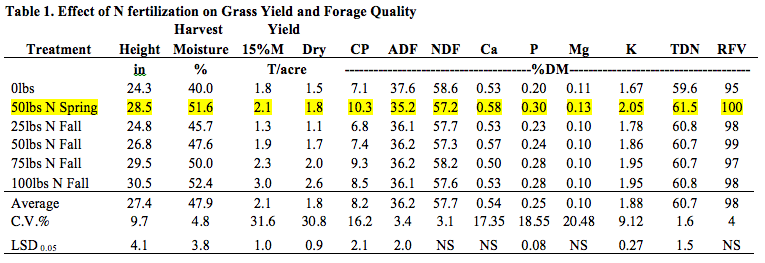
A demonstration conducted by colleagues at the Center this growing season utilizing the US Highway 281 ditch just south of the main entrance. The stand is primarily smooth Bromegrass, intermediate wheatgrass, and switchgrass. A fertilizer blend containing N and P was broadcast early May with an N rate of 33lbs/acre. It was harvested July 12. Again, there is a response to fertilization with increased yields.
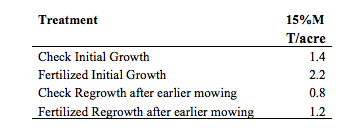
Therefore, if the economics permit, there is potential to increase both forage quantity and quality from existing, potentially overlooked, land resources.
Ezra Aberle
Agronomy Research Specialist
Excited About Manure
I had a colleague tell me last week that he’s never met anyone who gets “so excited about manure”. I will take that as a compliment and maintain that livestock manure in North Dakota is one of the highest-value, under-used fertilizer sources available.
As combines start rolling in the fields, I know that the custom manure haulers in North Dakota are ready to go, too. (Find one here: https://www.ag.ndsu.edu/lem) I’ve written Center Points posts previously about using manure as a fertilizer (https://www.ag.ndsu.edu/CarringtonREC/center-points/manure-fertilizer-use-recommendations) and about calibrating your manure spreader (you are spreading fertilizer, after all… https://www.ag.ndsu.edu/CarringtonREC/center-points/manure-spreader-calibration).
Today I write to invite you to the 2016 Nutrient Management Day, August 23. I think it deserves its own post because I’m featuring something new to our state: Mr. Andy Scholting from Nutrient Advisors LLC, West Point, NE will discuss manure brokering. Mr. Scholting primarily works with the livestock sector on producing the best fertilizer product possible for our crop-growing friends. He will be discussing both management and quality in the classroom as well as in the feedlot pens with a hands-on demonstration. I want both livestock owners and crop producers to join us for NM Day because it’s important for all of us to understand the value of this readily available resource.
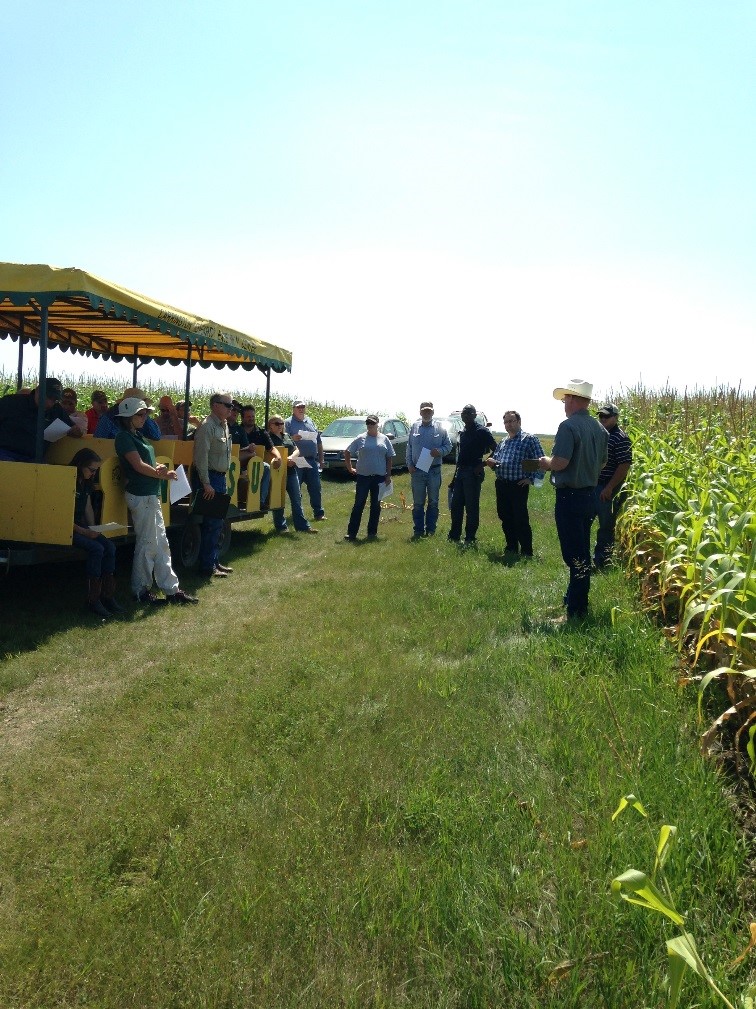
It’s hard to believe this is the first blog post for August. Maybe you’ve heard the adage, “the older you get, the faster time will seem to move;” I’m really feeling the effects of that saying this summer. It seems like Paulo and I just finalized our plot plans yesterday and it’s already time to show them off!
We will also be featuring Bison Compost LLP, who will be discussing creating quality compost. You can register for NM Day here: https://www.ag.ndsu.edu/CarringtonREC/events/2016-nutrient-management-day.
This week I’m heading east to Ohio for the North American Manure Expo (http://www.manureexpo.org/). I will share my findings with you at NM Day.
I look forward to seeing you on August 23rd at the CREC!
Mary Berg
Area Extension Specialist
Livestock Environmental Management
2016 CREC Field Days
Last week on July 19 the Carrington Research Extension Center hosted its 57th Annual Field Day. This year’s field day was attended by around 300 participants who had the opportunity to attend tours focused on research related to crop varieties and crop production; livestock production; organic crop production; northern hardy fruits; and plant nutrition, soil and pest management. The ‘Annual Field Day’ is a long-standing outreach event of not only the Research Extension Centers of NDSU, but similar programs across the country. Over the course of years the number of tours and workshops conducted during the summer season have increased as the CREC’s research programs have grown and diversified.
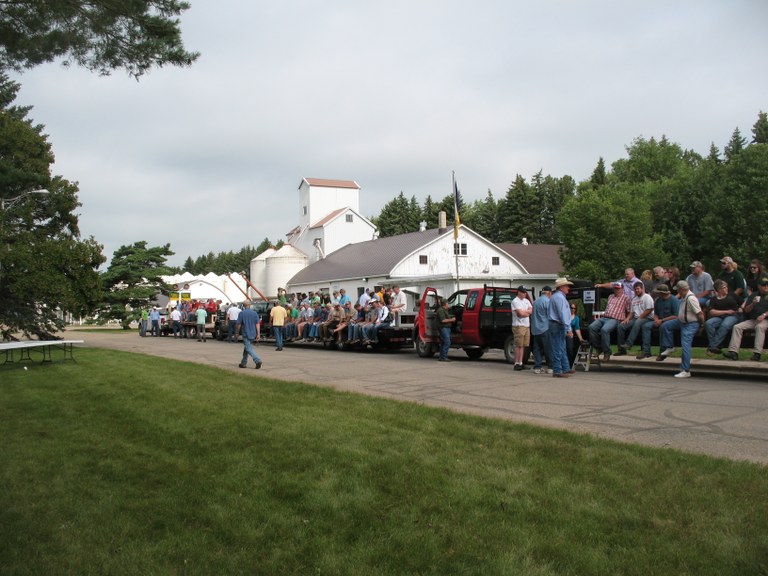
Besides our main field day, the Center conducts a series of annual events including the Crop Management Field School, Nutrient Management Day, Row Crop Day and a ‘Field Lab’ for agricultural students at the North Dakota State School of Science and Bismarck State College.
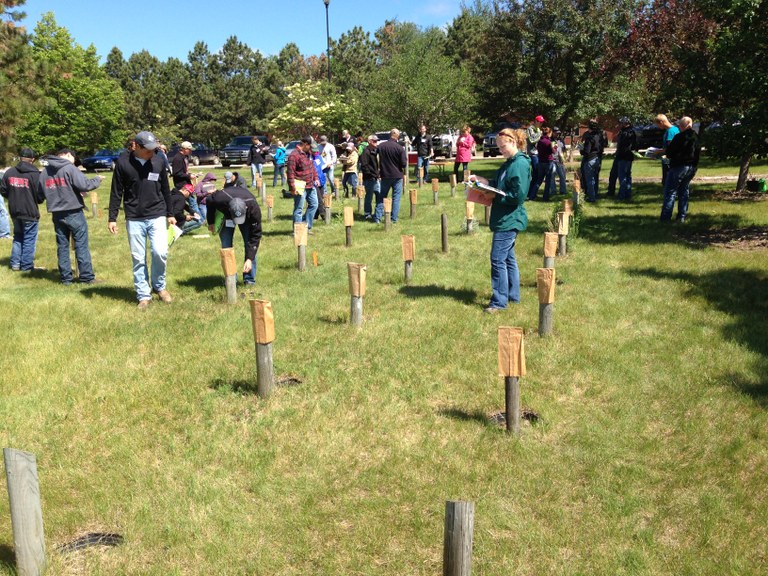
In addition to the annual tours we host at Carrington, we also organize tours at our off-station research sites at Dazey, Fingal, our Tri-County site near Wishek and at the Oakes Irrigation Research Site.
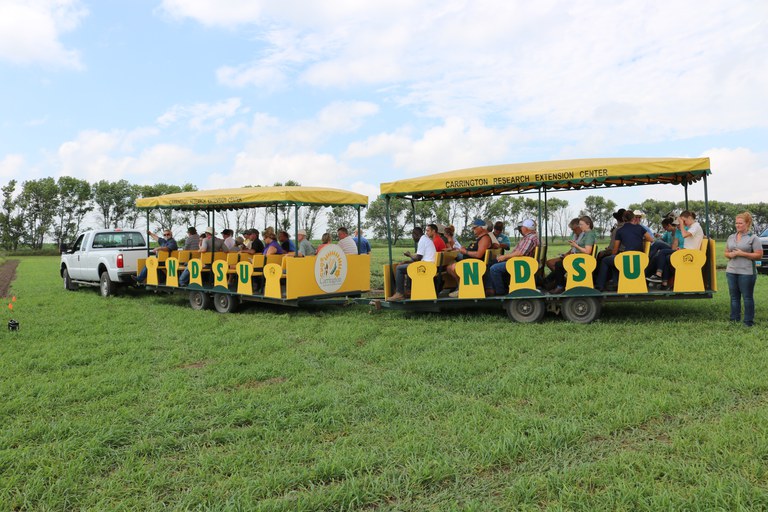
The CREC also hosts numerous other tours during the summer depending upon the interest and needs of our constituency. This summer we have had a North Dakota Weed Association sprayer clinic, North Dakota Corn Council and Corn Growers field tour, Lake Region State College agriculture students’ tour and educational session, and the CREC was part of the Carrington Medical Center Auxiliary Yard and Garden Tour. This year we will be having Community Tours on July 26 and August 30.
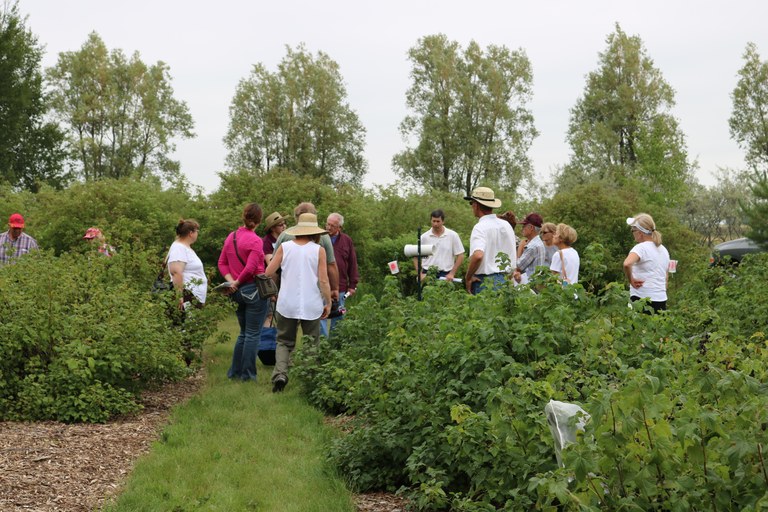
All the tours and trainings we provide are an effort to get information into the hands of producers, consultants and other constituency for use in their operations. Upcoming events are posted here: www.ag.ndsu.edu/CarringtonREC/events
- Community Tour – July 26
- Fingal Corn Tour – August 11
- Oakes Irrigation Research Site Robert Titus Research Farm Field Day – August 18
- Nutrient Management Day – August 23
- Row Crop Day – August 25
- Community Tour – August 30
We sincerely hope you can take advantage of some of the events we conduct.
Blaine G. Schatz
Director/Agronomist
Skid Steer/Front Loader Scale System
North Dakota State University does not endorse commercial products or companies even though reference may be made to tradenames, trademarks or service names.
During my first field season (2015) at the Carrington Research Extension Center (CREC) I had two trials with manure treatments. It took a lot of time driving to and from the scale to make sure the manure spreader had the correct amount of manure that I needed to apply to my plots. After that experience, I started to look at alternatives to make better use of my time, other than driving a tractor around pulling a manure spreader. My goal was to find an onboard scale system that could be installed on a skid steer to weigh the load in the bucket without having much impact (time wise) on the loading process. After some time looking for such product, I came across a system (Weighlog 100) made by a company in Nebraska and sold by Bobcat under the name of EarthForce. Since our skid steer is a Bobcat, we decide to purchase that system and get it installed (see photo below).
I believe a system such as this one can be very helpful to farmers and ranchers, since it can be used in many different ways. For those that have a nutrient management plan, for example, it would allow for one to keep records of how much manure is being applied to fields (record keeping). Another use for ranchers would be to measure how much feedstuff is being fed to livestock, such as the weight of hay bales. Due to the precision provided by the system (rounds to the nearest 10 lbs), this system is not considered legal for trade.
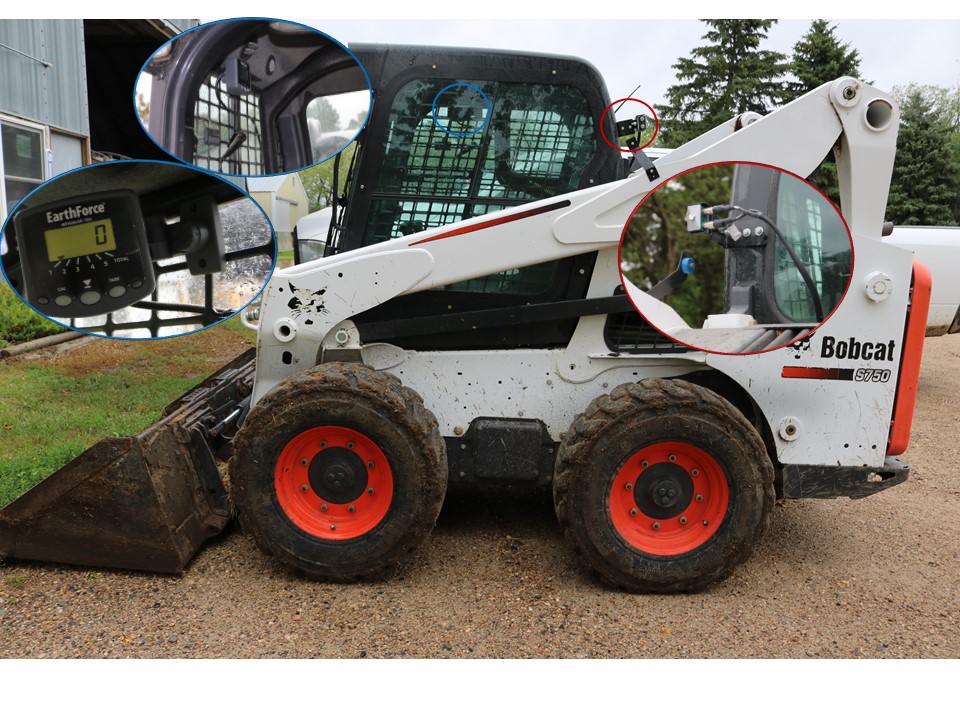
In a very simple way, the system mesures the weight of the load by measuring the hydraulic pressure in the hoses as the load is being lifted. There is a sensor mounted on the back of the skid steer cabin and one on the lifting arm (see photo). The system can be setup for either dynamic (measures weight as the bucket is being lifted) or static (bucket has to stop during the lifting process) measurements. We have it set up for dynamic measurements. When lifting a load, the sensor on the lifting arm passes in front of the sensor in the back of the cabin; the system takes a measurement and shows the weight on the screen inside the cabin (see photo). Taking a close look at the screen, one can see it has five different channels. That means the system can be set up for up to five different attachments. The system requires a calibration with a known weight for each attachment being used. For more reliable readings, the manufacturer advises to weigh the load on level surface if possible, while the machine is stationary, using the same RPM setting used during the calibration process, and it is important that the load do not bounce or jerk as it is lifted.
We used the system for the first time last spring. Having a pile of manure next to our plots and the onboard scale system on our skid steer improved tremendously our efficiency when applying manure to our plots, compared to the previous year. For more information about the Weighlog100, and other models, you can visit the manufacture’s website at http://loupelectronics.com/industrial-products/skid-steer-scales/weighlog-100.html. You can find other makes and models by doing an online search using phrases such as “skid steer onboard scale system”.
Paulo Flores, Ph. D.
Nutrient Management Specialist
57th Annual Field Day
The Carrington REC will host our 57th Annual Field Day on July 19. We gather at 9:00 a.m. for coffee and a welcome from Center Director Blaine Schatz. Tour wagons leave the yard at 9:30 a.m.
Participants will choose from four tours in the morning:
- Agronomy: NDSU plant breeders will review spring and durum wheat, barley, field pea, soybean and dry bean cultivars. Extension agronomists will discuss the status of corn and soybeans and end-of-season management.
- Beef production tours will highlight current feedlot research projects, winter rye forage systems, mortality composting management, predation control and profitability of feeding calves. Several live demonstrations are planned, including opening our mortality compost piles, calf implanting, and opportunity to access the rumen through cannulated steers.
- The Northern Hardy Fruit Evaluation Project was established in 2006 to introduce and demonstrate alternative, economically viable fruits that will grow in North Dakota. The project features grape, black currant and Juneberry variety trials as well as demonstration plantings of University of Saskatchewan cherries and haskaps; apples; aronia; red, white and black currants; elderberries; gooseberries; honeyberries; and plums. Fruit project manager Kathy Wiederholt will lead a tour of our fruit orchard; guest speaker and former Cornell University Extension fruit specialist Steve Makay will speak about black currants during the morning tour.
- Organic crop production management, organic variety trials and organic vegetable research continue to expand, in this, the 12th year since an organic field was established at CREC. Research specialist Steve Zwinger has scheduled tour stops featuring presentations from NDSU specialists and industry breeders and researchers.
A complimentary noon meal, catered by the Prairie Inn of Carrington, will be served before afternoon programming continues at 1:00 p.m.
Afternoon events include:
- Fruit specialist Steve McKay will discuss small-scale processing, fruit products and marketing in a classroom setting.
- A second agronomy tour:
A crop pest management update will look at sclerotinia in soybeans and dry beans.
Unmanned aerial systems used at CREC, phosphorus research, and crop management on variable topography will be highlighted during plant nutrition and soil management stops.
- An einkorn field evaluation will include participants in the selection process of developing a variety.
- Expanded organic land will be viewed during an informal tour.
- CREC’s new Agronomy Lab, completed just one year ago, will be open for viewing.
- Forty species of northern hardy trees and shrubs are available for inspection year-round at the CREC Arboretum, and self-guided walking maps will be available.
- CREC’s weed arboretum contains about 60 weeds arranged in groups including North Dakota noxious weeds, perennials, biennials, annual or winter annual grasses, annual broadleaves and winter annual broadleaves, all identified with labels.
The Carrington Research Extension Center is located 3.5 miles north of Carrington on Highway 281.
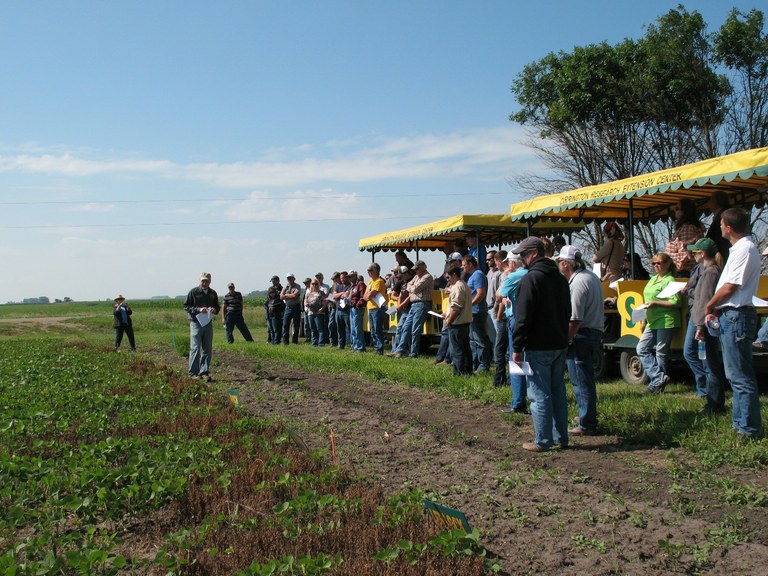
Linda Schuster
Administrative Secretary
Celebrating the Red, White and Black! And Pink…
Red, white, black and pink. These are all the colors of currant fruit! Are currants an all-American fruit? Yes and no.
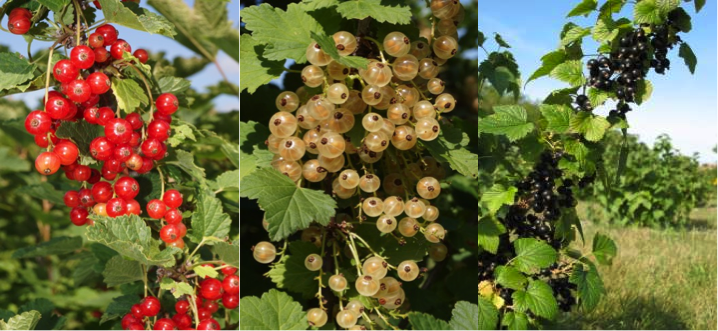
American currants (Ribes americanum), and other currant species, grow wild across much of eastern and central North America but are also found in the west. They are more subtle in their flavor and generally come in one color - black. They tend to ripen over an extended period. We grew the USDA-Plant Materials Center’s Riverview germplasm American currant at the CREC for about 5 years but we removed them due to old fruit being a place where pests can reproduce. The fruit was bland and we did not harvest it while more valuable fruit was being cared for.
Most currants used for culinary purposes today are European currants. They have a long history here in the US, having been brought here in the 1600s. By 1899, there were over 12,000 acres of currants grown in the US. In the early 1900s, white pine seedlings were imported from German nurseries to replenish the clear-cut pine forests of the East. These seedlings carried white pine blister rust; it doesn’t bother the currants too bad but it is deadly for young white pines. Because white pine was so important for the economy at the time, federal rules were enacted to ban currants and fund the eradication of all known plants in the genus. During the Depression and beyond, Civilian Conservation Corps members were employed by the eradication program.
Today the Federal ban is gone but due to their long absence, most Americans don’t know anything about the virtues of currants. They are really healthful for you! They are high in vitamin C, antioxidants and many minerals. They grow well here in North Dakota. The CREC’s shrubs were planted in 2007 and in eight seasons, they only failed to produce a crop once (May 2015 freeze).
Red, white and pink currants are all very similar to each other. They are a bit tart but are loved across the world for snacks and jam. Black currants, though, are where it’s at: tasty, flavorful and slightly funky. Black currant plants have oil glands on the leaves and stems and release their “heady, herbaceous aroma” when brushed. The fruit is a bit “piney” when raw (we call that ‘resinous’) but cooks up into a wonderful, bold, fruity flavor. In Europe, you can find black currants in tea, wine, jelly, syrup, ice cream, liqueur, juices and more.
Come to the CREC Field Day tour of the fruit project on Tuesday, July 19 at 9:30 am (arrive early). We are featuring currants! Our guest speaker is the US expert on currants: Steve McKay, retired Cornell Cooperative Extension fruit specialist. See you there!
Kathy Wiederholt
Northern Hardy Fruit Project Manager
IPM Crop Scout Program Update
The NDSU Extension Service IPM (Integrated Pest Management) field scouts currently are surveying four crops (wheat, barley, sunflower and soybean) for major diseases and insect pests, and taking general agronomic notes throughout North Dakota until mid-August. The purpose of the survey program is to monitor for the major pests of these field crops and to provide timely pest alerts for farmers and crop advisers.
The scouts choose random commercial fields. You may find a scout in your field someday this summer, and hope this is OK – they will be glad to share their notes with you! The NDSU IPM scouts are:
- Claire Endres, central and south central counties, working out of Carrington REC with Greg Endres.
- Brandi Herauf, southwest and west central counties, working out of Dickinson REC with Ryan Buetow.
- Hannah Kempler, north central counties, working out of NCREC in Minot with Travis Prochaska & Shana Forster.
- Taheni Gargouri, northwest counties, working out of Williston REC.
- Stafford Thompson & Taylor Senger, southeast and east central counties, working out of NDSU campus, Fargo with Jan Knodel, Andrew Friskop and Sam Markell.
- Jaime Lundquist, northeast counties, working out of Langdon REC with Leslie Lubenow and Benson County Extension Office with Scott Knoke.
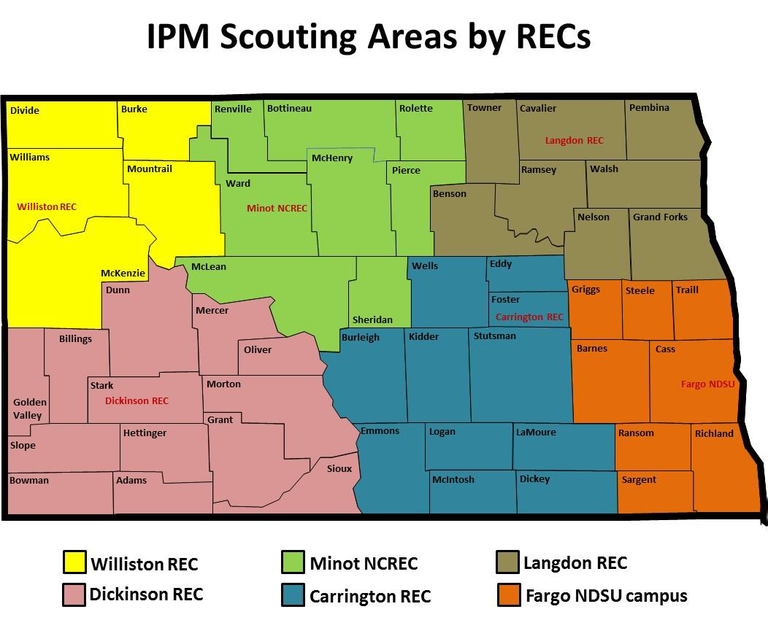
Survey results are posted in map format on the web page: www.ag.ndsu.edu/ndipm; and reported on in the NDSU Crop and Pest Report.
Greg Endres
Area Extension Agronomy Specialist
Sustainable Agriculture – USDA’s SARE Program
“Sustainable” is a term that has received a lot of attention in the food industry during the past few years. Even McDonald’s and the “Golden Arches” have a commitment to sustainability.
As farmers and ranchers, we have an inherent focus on sustainability. We want to hand down the farm or ranch to the next generations. We desire to leave the farm or ranch in better condition than when we started.
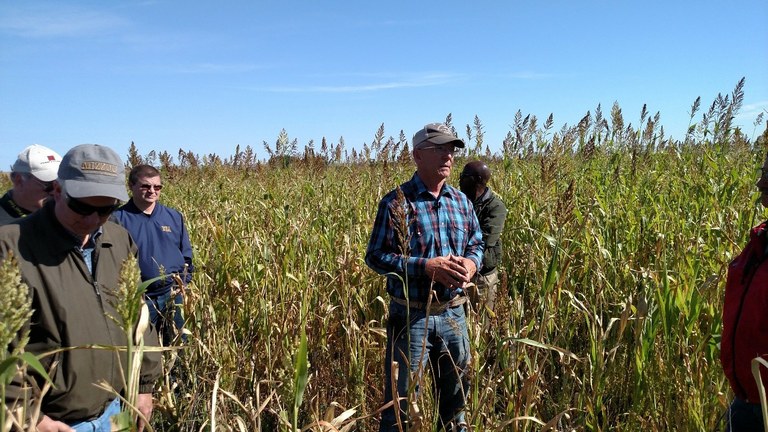
Producers are reviewing a cover crop planting used for building soil health and grazing cattle during the winter.
The three pillars of sustainable agriculture are: Economics (profitability), Environment (protecting our resources) and Community (keeping our social aspect). Almost all efforts on sustainability by government, associations, and businesses include these three pillars.
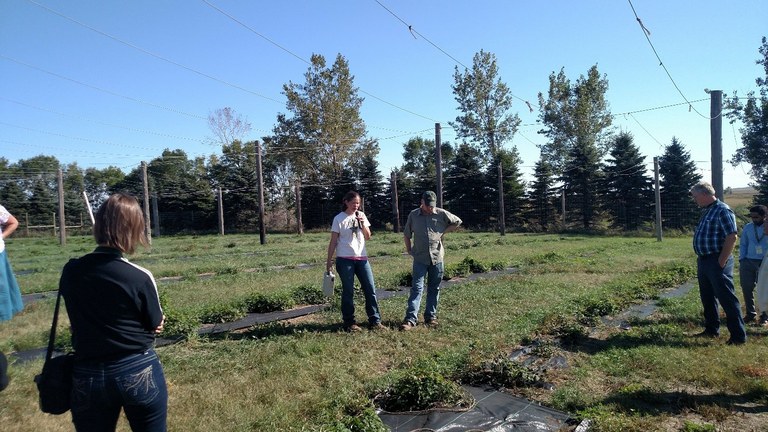
A young couple explaining their goals for producing hops.
The USDA (United States Department of Agriculture) has funded the SARE program for almost 30 years. SARE stands for Sustainable Agriculture Research and Education.
There is a tremendous amount of information on alternative ideas at www.sare.org. The 2015/16 Report from the Field highlights projects where SARE grant funds were used to try new ideas http://www.sare.org/Learning-Center/SARE-Biennial-Reports/2015-2016-Report-from-the-Field.
Besides information, SARE provides grant funds on a competitive basis. The SARE grant programs can be found at http://www.sare.org/Grants.
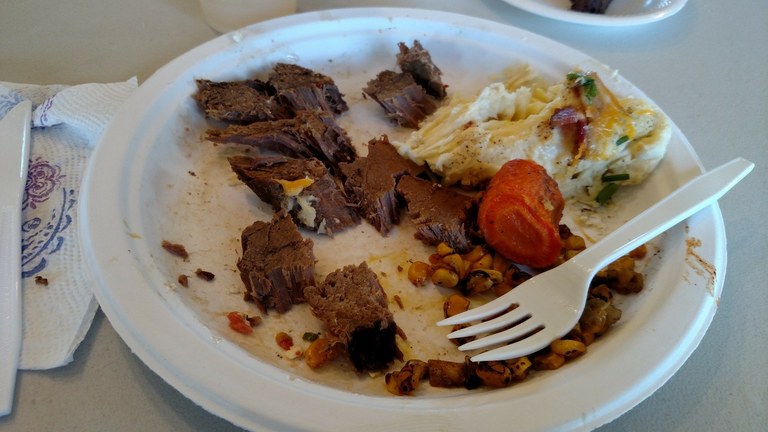
An excellent meal prepared entirely from locally grown or raised foods – a ‘freshtastic’ experience from the local foods movement.
The USDA - SARE program also has SARE State Coordinators in every state. North Dakota has two co-coordinators – Bill Hodous (Ramsey County Extension – Devils Lake) and Karl Hoppe (Carrington Research Extension Center) http://www.northcentralsare.org/State-Programs/North-Dakota
For more information about SARE, please check out the SARE internet sites listed above or contact Karl or Bill.
Karl Hoppe, Ph.D.
Area Extension Specialist – Livestock Systems
Co-Coordinator ND SARE
Alternative Summer Cow Nutrition: Feeding Cows in the Drylot
During the past 8 years, the CREC livestock unit has conducted focused research comparing year round alternative drylot management compared to a more traditional system of winter dry lot/summer pasture management.
Many producers are looking at this alternative cow management system for a variety of reasons. As a result we have been receiving several requests for example rations for feeding cows managed in a drylot throughout the summer. Feeding cows in the dry lot for the summer is not much different than in the winter, the big difference is adjusting the diets for the different stages of production.
We often see cow diets expressed on a percent of nutrient concentration in the diet such as percentage of crude protein (CP) and energy expressed as percentage of total digestible nutrients (TDN). The cow does not have a requirement for a percentage of nutrient, they have a requirement for a total amount of nutrient and these requirements change based on cow size and stage of production. Table 1 shows the TDN and CP expressed in total pounds required per head per day for cows at three different body weights and three main stages of production.
Notice both protein and energy requirements are greatest post calving, are lowest during the middle third of pregnancy and begin to increase again during the last third of pregnancy.
Table 2. lists two diets utilizing similar feed ingredients ( wheat straw, corn grain, modified corn distillers grain and a vitamin and mineral supplement containing an ionophore) but at different concentrations of the diet. Diet 1 is 76.8% dry matter and has an overall concentration of TDN = 59.0% and CP = 10.1% and a ration cost of $0.046/lb of diet on an as fed (wet basis). Diet 2 is 73.7% dry matter and has an overall concentration of TDN = 69.0% and CP = 12.2% and has a ration cost of $0.042/lb of diet on an as fed basis.
If we take these two diets and look at the nutrient needs for the post calving cows (table 1), diet 1 would need to be fed at 2.0% of body weight on a dry matter basis to meet the nutrient requirements of these cows (table 3.). The dry matter intake (DMI) would range from 26 lb/head/day for a 1200 lb mature cow to 28 lb/head/day for a 1400 lb cow. The diet is 76.8% dry matter so the actual feed delivered to the bunk would range from 34 lb/head/day (26 divided by percent dry matter of the diet 0.768) to 36.5 lb/head/day. The diet cost/head/day ranges from $1.55 to $1.66.
Since diet 2 is more nutrient dense or has a higher concentration of nutrients (both CP and TDN) we can feed less (Table 4). To meet the nutrient needs of a post calving cow diet 2 needs to be fed at 1.7% of body weight on a dry matter basis. Subsequently this diet also reduces the daily cow feed costs by 30 cents per cow per day.
This example demonstrates we don’t need to feed the cow all she can physically eat, we just have to feed her to meet her nutrient needs. Some cows can physically consume as much as 3.0% of her body weight in feed. These are only a few options that are available for feedstuffs in North Dakota, the options are plentiful. It is critical to test feedstuffs, know the size and nutrient requirements for the cows being fed, and balance the diet accordingly. For more information on Drylot beef cow/calf production check out the NDSU publication AS974 at https://www.ag.ndsu.edu/publications/livestock/drylot-beef-cow-calf-production/as974.pdf . Additional research information on drylot production and nutrition can be found at https://www.ag.ndsu.edu/CarringtonREC/livestock/cow-calf-production.
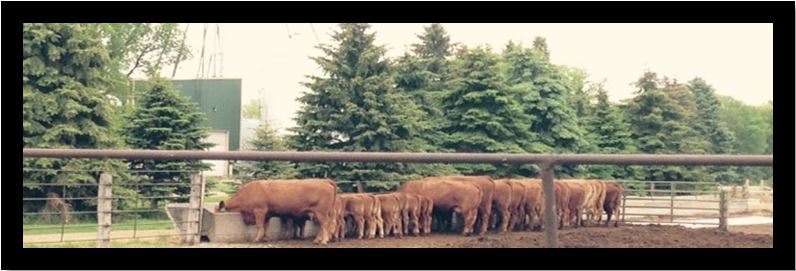
Chanda Engel
Livestock Research Specialist
Crop Diversity
Crop diversity, is it out there? A review of the plantings from the Carrington Research Center’s Foundation Seed Increase Program suggests it is. The information provided from our seed inventory, current planting acres and customer base locations will point out some interesting data.
Our current seed inventory for sale supports 8 crops and 32 varieties as shown in the table below.
The Center’s Foundation Seed Program has planted 12 crops and 31 varieties for the 2016 season. Four of the 12 are new crops and 11 of the 31 are experimental varieties. As with all experimental increases, some will be released and some will be dropped based upon the latest research trial test results from multiple years. The following table shows our planting acreages for 2016.
We planted a total of 1432 acres for 2016.
Our customer base reaches beyond the local region. For example, in the past 5 years CREC foundation grade seed has moved into 9 different states. This includes: North Dakota, South Dakota, Montana, Minnesota, Idaho, Wisconsin, Nebraska, Colorado and Michigan. Canada has also been a recipient of the Center’s seed.
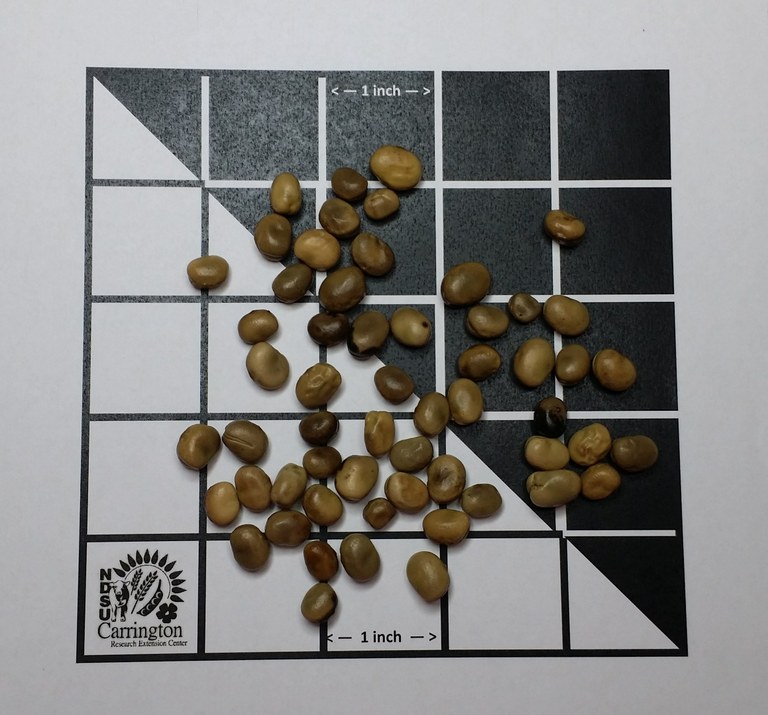
Faba Beans
Lastly, here are some highlighted points:
- Of the 12 crops grown for 2016, 9 are cool season and 3 are warm season.
- The 9 cool season crops are represented with 24 varieties and the 3 warm season crops have 7 varieties.
- The average acres for each variety is 46, with a range of 1 acre to 130 acres.
- There is a customer/seedsman who has a need for every crop and variety of foundation grade seed that we are growing.
Dave Copenhaver
Foundation Seedstocks Research Specialist


